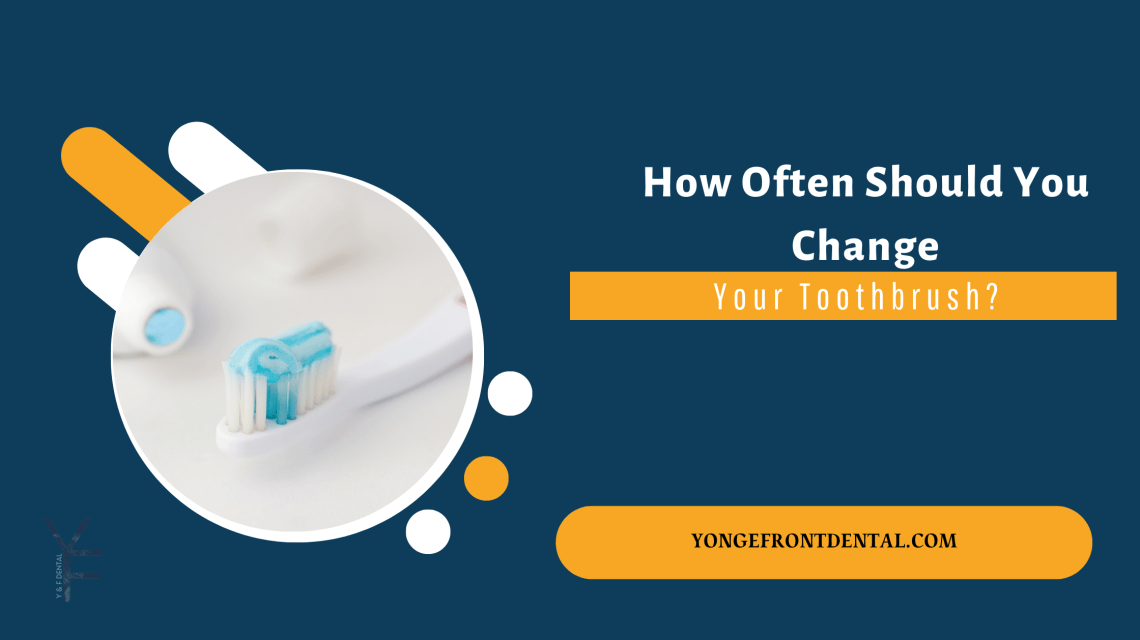In the daily routine of brushing teeth, most people focus on technique and thoroughness. However, there’s another crucial aspect of oral hygiene that many overlook: how often to replace your toothbrush.
When to Change Your Toothbrush and Why It Matters
At Yonge and Front Dental in Toronto, our dental professionals frequently remind patients that using an old, worn toothbrush can undermine their oral health efforts. Recent studies show that nearly 75% of people don’t replace their toothbrushes as often as recommended, potentially compromising their dental health.
This comprehensive guide explores the importance of regular toothbrush replacement, when exactly you should change yours, and how this simple habit contributes significantly to your overall oral health.
Why Regular Toothbrush Replacement Matters
Your toothbrush serves as your first line of defense against plaque, tartar, and bacteria that can cause decay and gum disease. However, over time, it becomes less effective and may even harbor harmful bacteria.
A study published in the Journal of Dental Research found that toothbrushes can accumulate over 10 million bacteria after just three months of regular use. These include streptococci, staphylococci, and lactobacilli – microorganisms that can contribute to dental caries and periodontal disease.
Beyond bacterial concerns, the physical condition of your toothbrush directly impacts its effectiveness:
- Worn bristles become less effective at reaching between teeth and along the gumline
- Frayed bristles can’t remove plaque as efficiently as new ones
- Bent bristles may damage gum tissue rather than clean it
- Older brushes may contain residual toothpaste that harbors bacteria
The connection between toothbrush condition and oral health is clear: as your toothbrush deteriorates, so might your dental health.
The Standard Recommendation: Every 3-4 Months
Both the Canadian Dental Association and the American Dental Association recommend replacing your toothbrush every three to four months. This timeframe isn’t arbitrary – it’s based on extensive research into how toothbrushes deteriorate and lose effectiveness over time.
Most dentists, including our team at Yonge and Front Dental, suggest using this timeline as a general guideline. However, visual inspection is equally important. Here’s what to look for:
Signs it’s time for a new toothbrush:
- Frayed, splayed, or bent bristles
- Discoloration that doesn’t wash away
- Bristles that feel soft and no longer springy
- Residue buildup at the base of the bristles
- A noticeable odor even after rinsing
Take a moment right now to examine your toothbrush. If you notice any of these signs, it’s time for a replacement – even if you haven’t reached the three-month mark.

Special Circumstances That Require More Frequent Replacement
Certain situations call for replacing your toothbrush sooner than the standard recommendation:
After Illness
When you’ve been sick with a cold, flu, or any infection, your toothbrush can harbor the very germs that made you ill. Research from the University of Manchester showed that viruses and bacteria can survive on toothbrush bristles for up to three days after use.
“I always advise patients to replace their toothbrush after recovering from any illness,” says Dr. Chen. “It’s a simple precaution that can help prevent reinfection or prolonged illness.”
For Patients with Oral Health Conditions
If you have gum disease, recurring oral infections, or are undergoing dental treatments, your dentist might recommend more frequent toothbrush replacement. People with compromised immune systems should also consider changing their toothbrushes more often – approximately every 4-6 weeks.
Children’s Toothbrushes
Children often brush more vigorously and may chew on their toothbrushes, causing faster deterioration. Additionally, children’s developing immune systems may benefit from more frequent toothbrush changes. Parents should inspect children’s toothbrushes every two weeks and replace them approximately every two months.
Impact of Aggressive Brushing
If you tend to brush forcefully (which we don’t recommend), your toothbrush will wear out faster. Those who brush with heavy pressure may need to replace their toothbrushes as often as every six weeks.

Tips for Extending Your Toothbrush Life
While regular replacement is essential, proper care can help maintain your toothbrush’s effectiveness between changes:
Proper Cleaning and Storage
After each use:
- Rinse thoroughly under running water
- Tap excess water off
- Store upright in a holder that allows air circulation
- Keep toothbrushes separated if storing multiple brushes
Avoiding Common Mistakes
Many people unknowingly damage their toothbrushes through these common habits:
- Storing in closed containers, which promotes bacterial growth
- Placing near toilets, where airborne bacteria can settle on bristles
- Sharing toothbrushes with family members
- Using toothbrush covers that trap moisture
Toothbrush Sanitizers: Do They Work?
UV toothbrush sanitizers claim to kill 99.9% of bacteria on toothbrushes. While studies show they do reduce bacterial counts, they don’t eliminate the need for regular replacement. Sanitizers address bacterial concerns but not the physical wear of bristles.
A more cost-effective approach is to occasionally soak your toothbrush in antibacterial mouthwash for 30 seconds or a solution of one part hydrogen peroxide to three parts water.
Electric Toothbrush Heads: Different Rules?
Electric toothbrushes have become increasingly popular, but their replacement schedules differ slightly from manual brushes.
The American Dental Association recommends replacing electric toothbrush heads every 12 weeks. However, because electric toothbrushes often brush more efficiently with oscillating or sonic movements, the heads may show wear faster than manual brushes.
At Yonge and Front Dental, we’ve observed that patients who switch to electric toothbrushes often experience improved oral health. The built-in timers and pressure sensors help ensure proper brushing technique, which can lead to better cleaning even as the brush head ages.
When considering cost, remember that while electric toothbrushes require a higher initial investment, replacement heads typically cost less than full manual toothbrushes. Many manufacturers offer subscription services that deliver new heads at recommended intervals.

Recommended electric toothbrush features:
- Pressure sensors to prevent aggressive brushing
- Two-minute timers with 30-second quadrant indicators
- Multiple cleaning modes for different needs
- Replaceable heads that are easy to find
- Battery life indicators
Creating a Toothbrush Replacement Schedule
Making toothbrush replacement a regular habit requires some planning. Here are practical strategies our patients have found helpful:
Practical Reminder Systems
- Mark your calendar or set a smartphone reminder for every three months
- Replace your toothbrush on the first day of each season
- Buy toothbrushes in multi-packs and set a schedule to open a new one monthly
- Change your toothbrush after each dental cleaning (typically every six months) and once in between
Family Replacement Strategies
For families, coordinating everyone’s toothbrush replacement can be challenging. Consider:
- Assigning each family member a specific replacement day
- Using different colored toothbrushes and rotating colors with each replacement
- Making it a family event where everyone changes brushes simultaneously
- Setting up a subscription service that delivers new brushes for the whole family
Subscription Services
Many oral care companies now offer subscription services that deliver new toothbrushes or electric toothbrush heads at regular intervals. These services:
- Eliminate the need to remember replacement dates
- Often provide discounts on regular purchases
- May include other dental hygiene products
- Reduce environmental impact through minimal packaging

How Your Dentist Can Help
Your dentist is your partner in oral health, and that includes guidance on toothbrush replacement. At Yonge and Front Dental, we evaluate each patient’s brushing technique and toothbrush condition during regular check-ups.
Based on your specific oral health needs, brushing habits, and any existing conditions, we may recommend customized replacement schedules. For example, patients with braces might need more frequent replacements due to additional wear from cleaning around orthodontic appliances.
During your regular six-month check-ups at our Toronto clinic, we provide complimentary toothbrushes to encourage regular replacement. We also offer personalized recommendations for toothbrush types based on your specific needs – whether you have sensitive gums, dental restorations, or other considerations.
Conclusion
Replacing your toothbrush every three to four months is a simple yet crucial aspect of maintaining good oral health. By following this guideline and paying attention to the condition of your brush, you can ensure that your daily oral hygiene routine remains effective.
Remember that your toothbrush is a tool that works hard every day to keep your mouth clean and healthy. Treating it as a regularly replaceable item rather than a permanent fixture is essential for optimal dental health.
At Yonge and Front Dental in Toronto, we’re committed to helping you maintain excellent oral health through professional care and practical advice for your at-home routine. If you have questions about toothbrush selection or replacement, or if you’re due for a professional cleaning, our team is here to help.
Contact us today to schedule your next appointment and receive personalized guidance on all aspects of your oral health care routine.


